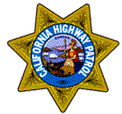

CHP RADIO SYSTEMS
PART 3
1977-1988
THE 1977 RADIO FLEET
In 1976, the specifications for a new generation of CHP mobile radios were prepared. This radio would retain the current four channel scheme, however there would be a few differences. The microphones would have a special "rocker" switch as described below, the radios would have dual receivers, and the power output would be increased to 100 Watts. This contract was awarded entirely to Motorola.
The 1977 radios were the "Micor" model, a special production unit. Types X71RTA-4413AA and X71RTA-4413AK, under purchase orders 00118 and 01399. These were 100 Watt transmitters with dual receivers, such that the patrol cars could hear the transmissions of nearby cars as well as the station, even when the other cars were transmitting in the usual "car to station" mode. The microphone was a special model with a "rocker" switch for push-to-talk. Depending upon which side of the "rocker" was pressed, the radio would transmit to the station, or in the "car-to-car" mode.
The five single-tone burst feature was retained in this series of radios, and is the row of "ST" buttons across the top of the control head. This feature was rarely used other than to unmute the dispatch consoles in areas other than the division where the mobile unit was used. In other words, if a mobile unit traveled to a different division, its radio would not have the correct frequency or PL tone for that division. So, to talk to the dispatcher, the mobile unit would switch to the statewide Blue channel and use either Tone 1 or Tone 5 depending on the area to talk to the dispatcher in that division. Apparently the tone was used so that the dispatch console was normally muted on the Blue frequency unless the tone was received, so that dispatch was not distracted by the assorted random traffic that exists on that frequency. This feature became unnecessary by 1989 when the GE RANGR radios were placed into service, as the RANGR equipment has all frequencies, statewide, built-in as well as all PL tones.
Most of the installations of this equipment used the factory stereo speakers in the dash of the vehicle rather than the stock Motorola speaker. Hence the lack of visible speaker in original photos of vehicle interiors. The Ford Mustangs of the 1980's were ordered with stereo speakers of an impedance designed to match the Micor radio output, for this reason.
The control heads as delivered from Motorola have "California Highway Patrol" lettering on the right side of the upper section. The buttons across the lower row are OFF, Primary channel, Secondary channel, MON and PL. MON refers to activation of the second receiver, the purpose of which, as described above, is to allow reception of transmissions from other cars when they were talking to the dispatcher. PL is the standard PL "Private Line" sub- audible tone switch as used in the earlier radios. Activating the PL switch mutes the receiver except to transmissions having the correct PL tone. The noise blanker ("extender") feature of the earlier radios was retained, however it is always on, and there is no way to turn it off as there was on the Motran and Super Fleetfone CHP radios.
The CHP Micor radio drawer unit itself is considerably longer than a regular Micor, to accommodate the additional receiver added across the rear apron. Since channel scanning was available at the time, it is not known why a second receiver was supplied, since it would appear that a priority-scan control head would have accomplished the same purpose without the need for a costly second receiver, particularly when the frequency separation involved was small. The Micor radio was mounted on a sheet of plywood which was fastened to the hump in the upper rear trunk of the patrol car.
A number of the CHP contract Micor radios were also delivered to the State of California Department of Parks and Recreation, tuned to their 45 MHz channels rather than CHP frequencies, to supplement their aging RCA 700 and 1000 series mobile radios. Parks and Recreation abandoned their low band channels, statewide, in approximately 1979 through 1980 and moved to an 800 MHz analog system, and it is presumed that the CHP Micor equipment used by them found its way back to CHP inventory at that time.
The only control heads to escape later modifications were those transferred to the Department of Parks & Recreation in 1977. The heads shown below are as they would have been found in CHP service 1977-1980, except that the SEC and ST5 buttons would have been blue in color. Apparently the Parks & Recreation Department changed the button colors.
The photo below shows the final version of the CHP's Micor control head, as modified by GE to allow the use of a vehicular VHF high band repeater, as explained below. These were used from 1980 to the end of service in 1987-88.
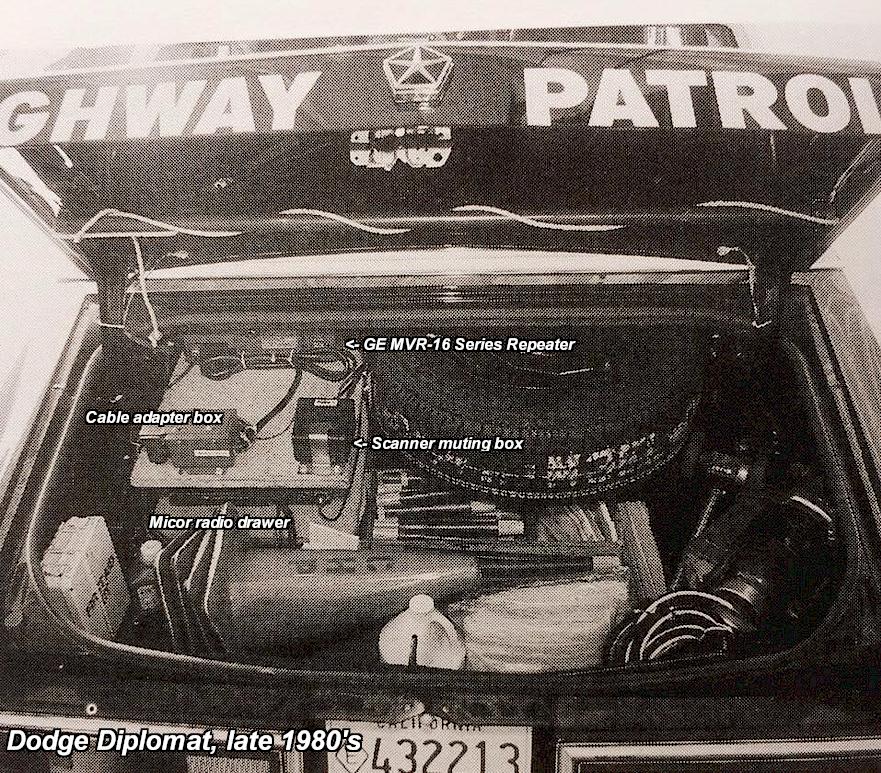
Shown below is a CHP instruction sheet which would have been found in the cars in 1977-89 describing use of the Micor radios. Thanks to Don Schafer for these.
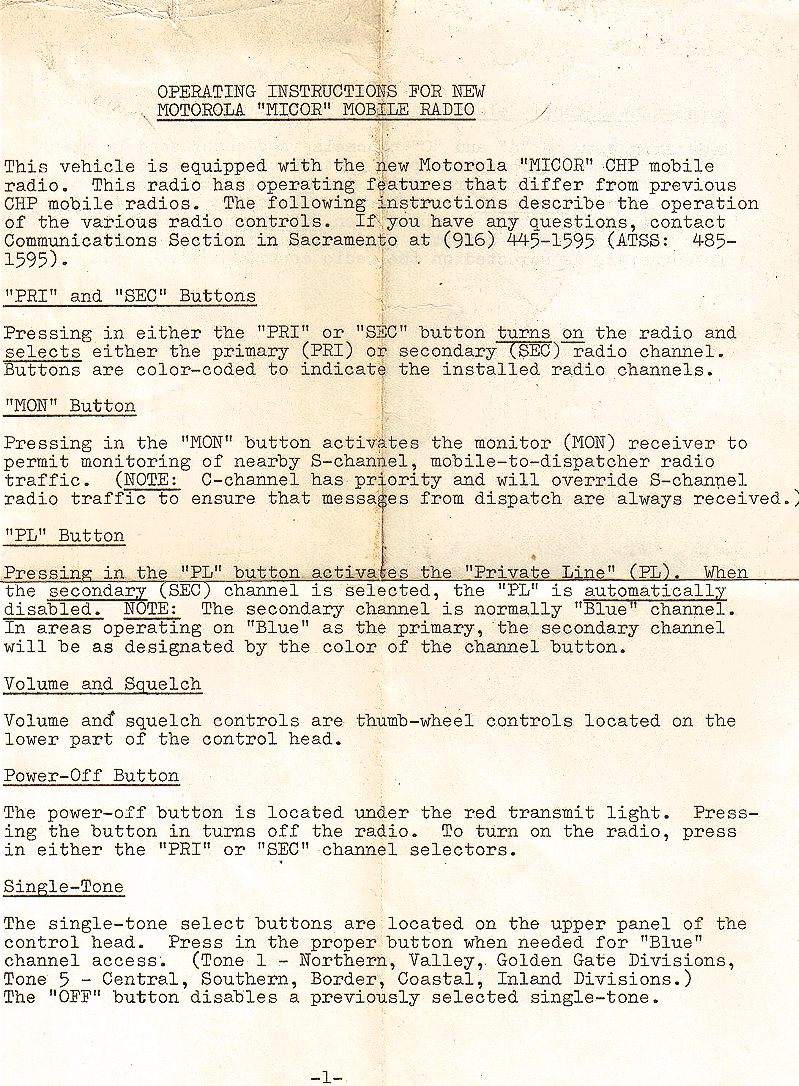
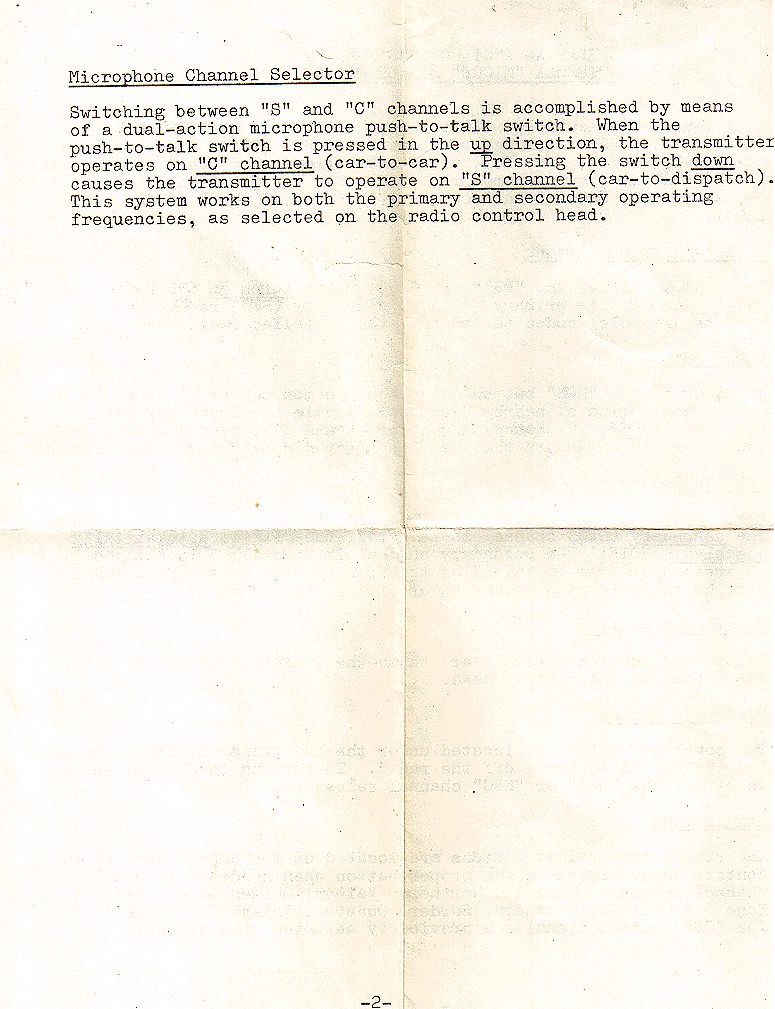
Also, here is a sample of the card carried in the cars to exp-lain how to use the BLUE channel with the Micor radios:
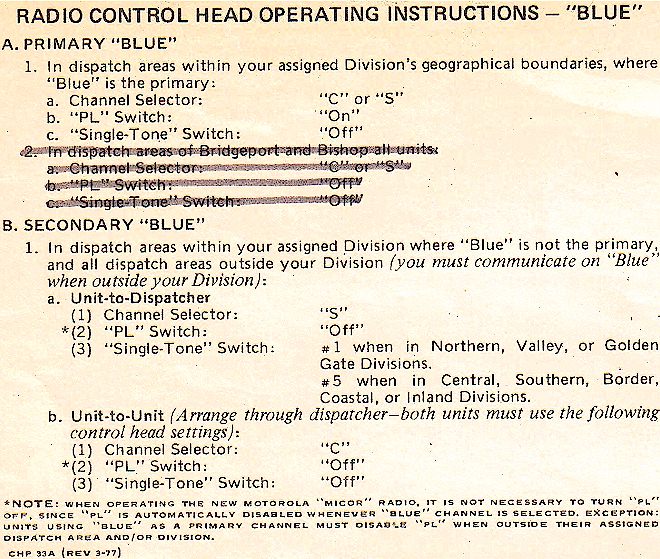
THE GE "EXTENDERS":
Although hand-held radios had been experimented with in the late 1960's, is wasn't until late 1979 that it was decided that the patrol officers should have hand-held personal radios. These are technically impractical in the frequency range which CHP equipment operates (42 MHz). CHP therefore obtained a VHF "high band" frequency assignment of 154.905 MHz, on which to operate its fleet of hand-held radios. In order to use these radios, it was decided that each car would have a mobile repeater system which would take the high band signals from the hand-held radio and interface them with the low band mobile radio in the vehicle. A decision was made to purchase GE hand held radios and mobile repeaters, evidently because they were the low bidder, and a purchase order was released to GE on June 4, 1980 (P.O. Number 22433.) This was quite unusual, because the GE equipment would have to be wired into the existing Motorola Micor radios, necessitating partial disassembly and modification of the Motorola radio, to interface it with a competitor's incompatible product. This was the first major CHP mobile radio contract given to GE in twenty years and was in the amount of $ 3.7 Million. (Details reported in the APCO Bulletin, November 1980.) GE supplied the repeater unit and the necessary modification kit for the Motorola mobile radio, and the Micor radio fleet was then gradually modified over a period of approximately one year, by State Of California communications technicians, in the field at the various regional shops and in the Sacramento shops as new vehicles were placed into service. The bulk of the work in the field was carried out by traveling communications technicians Gary Eberle and Jerry Short, with occasional assistance from technicians in the area shops. Eberle recalls personally installing over 800 of the kits, and would probably prefer to never see another one!
The modifications included a new circuit board with two pushbutton switches, added to the control head in the upper right corner, labeled "reset" and "rpt". A new adhesive faceplate strip was supplied for the control head's upper deck, such that the control heads no longer said "California Highway Patrol" on the right upper face. A somewhat crude extra cable was added, coming out of the rear of the control head, which terminated in a plastic Molex plug a few inches from the rear cover. A GE "MASTR Executive II" mobile "repeater" unit, model MVR16HS-SPL, was added in the cruiser trunk adjacent to the MICOR radio drawer unit . The MVR16HS is actually a 100 mw output low power simplex relay unit, which the CHP called a "mobile extender" or just "extender". The word "extender" was somewhat of a misnomer as it normally refers to Motorola's trademarked ignition noise blanker circuit. The "extenders" began to be installed in CHP vehicles during the fall of 1980. By late 1981, all CHP vehicles should have had the modification completed. The portable radios were MPR Series hand-helds, model P2BJJ65BEN-SPL, as shown in the photo below. These were two-channel radios; the main "RPT" channel was 154.905 MHz while the second channel, "CLE", was 154.920 MHz, the California Law Enforcement Mutual Aid channel (CLEMARS.)
The first systems were designed to feature an "emergency" switch on the handheld radio which would automatically place the MPR handheld in the transmit mode when activated, sending a special PL tone to the MVR repeater unit. This was intended by GE to send an emergency tone to the dispatcher via the patrol car's Motorola low band radio, but the CHP originally planned to install a tape recorder in the patrol car. When the officer made a traffic stop, he would record the license number, location and other details before exiting the patrol car. If the emergency button was pressed later, this message would go out over the air along with an "emergency" tone. However, for rather obvious practical reasons the CHP never installed the tape recorders. Thus, the only thing which would happen when the emergency switch was activated, was that a "beep" tone with no unit identification would go out over the air. In Sacramento, for example, it was typical to receive about 30 false alarms during each shift from accidental activations of the emergency toggle switch on the officer's GE hand-held radios, so the portables were systematically called in and the emergency switches and circuitry entirely removed ! The cable for this function can usually be seen still hanging from the connector of the original MVR cable assembly.
An interesting anecdote is that the GE MVR units, as originally supplied, failed to meet contract specifications due to the use of solid core rather than stranded wiring inside. GE was forced to supply technicians to make the wiring changes, who spent months at the State of California Communications Division warehouse in Sacramento rewiring the thousand-plus mobile repeaters already delivered !
HOW THE EXTENDERS WORK: The "extender" mobile repeater transmits and receives on the same channel. It works by pulsing the signal it is transmitting, so that it can still listen on its own frequency to check to see if the officer's hand-held radio is transmitting to it. During periods of no activity from the dispatch system, the mobile repeater is idle and simply listens on the 154.905 frequency. When it receives a signal from the hand-held on 154.905, it puts the car's low band radio on the air and relays what it hears (on 154.905) out on whatever 42 MHz CHP channel the main mobile radio is on. When the channel is active with dispatch traffic on the 42 MHz channel, the mobile repeater re-transmits it on 154.905, but interrupts it with short pulses, so that it can listen to see if the hand-held radio wishes to break in. The mobile repeaters had a range of perhaps a mile or less. In order to prevent interference when several CHP patrol cars arrive at an accident scene, the mobile repeaters have a priority scheme, which basically shuts down all mobile repeaters except the last one to arrive at the scene. Hence the "reset" switch on the control head.
GE's original intent was to have a vehicular charger in the patrol car, and when the hand-held was pulled from the charger once the patrol car arrived on the scene, the "reset" function would be automatically performed. However, most CHP cars never had the vehicular charger console installed. Instead, the hand-held radios were stored in rack chargers at the CHP offices and removed as officers went on their shifts. Therefore, it was necessary to manually activate the "Reset" switch on the radio control head. The extender system appears to have been an improved copy of a system "invented" by a California firm named PSI in the late 1960's, which was installed in the patrol cars of at least one central California sheriff's department, and evidently a number of them were purchased by the CHP for evaluation in those years.
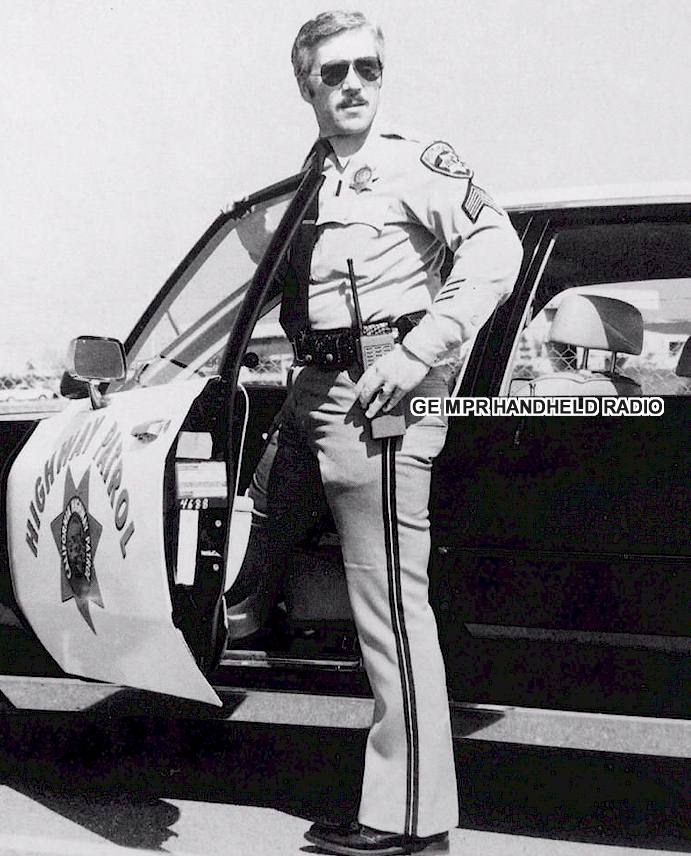
CLICK HERE TO VIEW THE SPECIAL TEST FIXTURES USED ON THE GE MOBILE REPEATERS
The model numbers for the GE equipment on the first mobile extender system implemented in 1980:
Model MVR-16HS-SPL Vehicular Repeater (Executive II housing)
Model P22BJJ65BEN-SPL Personal Radio Unit, MPR (see photo above)
Model 351L4A1X Single portable radio charger
Model 352L4B1X Multiple portable radio charger (gang charger)
( Note that there were no in-vehicle charger consoles and that the "SPL" in the model numbers above does not appear on the serial number sticker of the equipment itself.)
Ver. 6/18/2020 © Geoffrey C. Fors 1998 All rights reserved